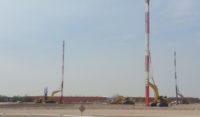The Texas Railroad Commission has issued a citation to the DeLoach Oil and Gas Wastewater Disposal Co. in southeast Texas that accuses the company of violating permits for disposal of saltwater, which some geologists believe may be the cause of a massive sinkhole in the tiny town of Daisetta.
The U.S. Geological Survey and a team of researchers, meanwhile, are still trying to determine exactly what caused the small sinkhole that began as 20-ft hole earlier this month to grow into an oily 900-ft wide, 300-ft-deep lake, where an alligator has taken up residence.
When the sinkhole collapsed on May 7, it brought down oil-field equipment, telephone poles and several vehicles, but caused no injuries. The once-booming Texas oil town, population 1,000, is some 60 miles northeast of Houston. No air or water pollutants have been reported by the Texas Natural Resources and Conservation.
Because Daisetta sits on a salt dome in the earth, it was initially thought the hole occurred as a result of groundwater leaking into the salt dome. A later theory is that the pit formed as a result of saltwater from oil production, stored underground, eroding the salt dome.
The commission says the cause hasn’t been determined.
"No link has been made between the sinkhole and the nearby injection well or any other injection wells located in the area," says Ramona Nye, spokeswoman for the Railroad Commission, which regulates the state's oil and gas industry.
Officials of the DeLoach Oil and Gas Wastewater Disposal Co. could not be reached for comment. The railroad commission also cited the firm for failing to conduct its annual leak test on the piping in the disposal well before April 30.
Nye says there are about 50,000 permitted injection/disposal sites in Texas, and about 30,000 are active. "Two-thirds of the wells are injection wells used for enhanced oil recovery."
She adds that the commission examined the operations and records of all wells in the area to determine if the sinkhole was the result of oilfield activity and cited DeLoach for "failure to comply with its permit injection volume limits."
The DeLoach-operated well is permitted to inject 3,000 barrels a day or 90,000 barrels a month. Nye says the operator was injecting volumes ranging from 128,000 barrels a month to 192,000 barrels a month for 2007.
"A review of the annual reports indicate this violation occurring since 2004," Nye says. Prior to February, the RRC relied on a manual review of the permit volume limits, she says. The agency now automatically sends violation notices when permit volume or pressure limits do not match those reported in the annual reports.
"This allows for a much more thorough review, and would have identified the volume concerns at DeLoach that the manual review did not catch," she says.
The sinkhole's growth rate is being monitored with terrestrial laser scanning combined with GPS and high-resolution photography to image the surface expression of the sinkhole to accuracies of a few millimeters. High-resolution GPS measurements will assess vertical and horizontal motion in a broad area around the sinkhole.
Carl Norman, a geologist from the University of Houston, says large sinkholes can grow for months.
"For a salt dome, this is a very large one," Norman says.


Post a comment to this article
Report Abusive Comment